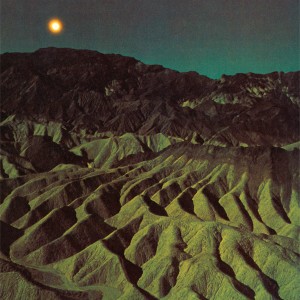

On Sept. 13, San Francisco duo Barn Owl will release their sixth album (and second full-length release this year following the excellent Shadowland) titled Lost in the Glare. Since 2006, Jon Porras and Evan Caminiti have been playing their own mix of drone, psychedelic and folk music with a gritty western feel. On this release, the two mainly use electric guitar and Farfisa organ with additional keyboards, field recordings and manipulated cassette tapes. As with previous Barn Owl records the atmosphere is rich and vibrant, joining the celestial guitars with the calming hum of the organ. On occasion the two branch out into more a intense, distorted sound, breaking up the record and giving the listener some breathing space before ejecting them into a grand and inquisitive vacuum of sound.
The structure of Lost in the Glare is reminiscent of other Barn Owl releases, with the earlier tracks easing into the more spacey exploration of the later songs. The album kicks off with “Pale Star,” an entrancing mix of reverb drenched lead guitar and industrial keyboard and resonant guitar tones. The second track, “Turiya,” introduces drums into the dusty landscapes with a serious western twang. “Devotion I” plays up the genre in an incredibly detailed atmosphere, contrasting the heavy riffage on “The Darkest Night Since 1683.” After this dark crescendo, the impressive guitar work and writing shine on “Temple of the Winds,” with “Midnight Tide” reintroducing a percussive pulse back into the sound. “Light Echoes” begins with a beautiful solo guitar as others slowly emerge with the radiant organ until piercing guitar tones take over. The final track, “Devotion II,” features relatively robust drumming slowly evolving into the last dirty cries of distorted guitar and feedback.
The later tracks are where Barn Owl really shines, not only showing Porras’ and Caminiti’s great guitar work, but expanding and morphing the atmosphere of sound with each track. The heavily distorted doom on “The Darkest Night Since 1683” allows the subsequent songs to open up, as the hollowness of the sound is subtly probed by acoustic guitars and a healthy dose of Farfisa organ (replacing the harmonium found on many previous releases). Additionally, these songs diverge a bit more from the “alone-in-the-desert” feeling earlier in the album.
If there is anything disappointing on Lost in the Glare, it is the group’s resignation to let songs fade into ambient drone passages. At times it can be an elegant transition, but after a few listens it can become too much deceleration for an album filled with so much delicate wonder. Still, this should not stop people from checking out what may be the best album of 2011. Lost in the Glare has more originality and experimentation than some bands have in their entire discography—just sit back and let the music guide you.
